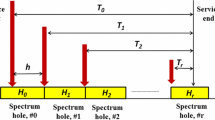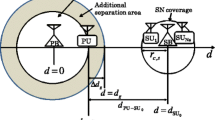Abstract
Cognitive radios have demonstrated its ability in improving spectrum efficiency. Along with the popularity of mobile broadband devices in future mobile communications, research for cognitive radios with mobility will be paid more and more attentions. In a mobile cognitive radio network, we derived the analytical expression for the dynamic spectrum access opportunity of secondary users in spatial and temporal dimensions. Through maximizing the spatial-temporal opportunity, we obtained the closed-form solution of the optimal guard distance, which is a key part of primary protection region against the mobile secondary users’ interference. Numerical results verified the accuracy and correctness of our theoretical analysis, and indicated that using our solution the secondary user has more spatial-temporal opportunity than the existing research result.








Similar content being viewed by others
References
Devroye, N., Vu, M., & Tarokh, V. (2008). Cognitive radio networks. IEEE Signal Processing Magazine, 25, 12–23.
Hong, X., Chen, Z., Wang, C.-X., Vorobyov, S. A., & Thompson, J. S. (2009). Cognitive radio networks. IEEE Vehicular Technology Magazine, 4, 76–84.
Xuemin, H., Jing, W., Cheng-Xiang, W., & Jianghong, S. (2014). Cognitive radio in 5G: A perspective on energy-spectral efficiency trade-off. IEEE Communications Magazine, 52, 46–53.
Weijia, H., Jiandong, L., Qin, L., & Linjing, Z. (2011). Spatial false alarms in cognitive radio. IEEE Communications Letters, 15, 518–520.
Furtado, A., Irio, L., Oliveira, R., Bernardo, L., & Dinis, R. (2015). Spectrum sensing performance in cognitive radio networks with multiple primary users. IEEE Transactions on Vehicular Technology, 65, 1564–1574.
Zhao, Q., & Swami, A. (2007). A decision-theoretic framework for opportunistic spectrum access. IEEE Wireless Communications, 14, 14–20.
Kim, K. J., Kwak, K. S., & Choi, B. D. (2013). Performance analysis of opportunistic spectrum access protocol for multi-channel cognitive radio networks. The Journal of Communications and Networks, 15, 77–86.
Jin, L., Dutkiewicz, E., Ren Ping, L., & Vesilo, R. (2015). Opportunistic spectrum access with two channel sensing in cognitive radio networks. IEEE Transactions on Mobile Computing, 14, 126–138.
Min, A. W., Kim, K.-H., Pal Singh, J., Shin. K. G. (2011). Opportunistic spectrum access for mobile cognitive radios. In Proceedings of 30th IEEE international conference on computer communications (INFOCOM’11), Shanghai (pp. 2993–3001).
ElSawy, H., Hossain, E., & Haenggi, M. (2013). Stochastic geometry for modeling, analysis, and design of multi-tier and cognitive cellular wireless networks: A survey. IEEE Communications Surveys and Tutorials, 15, 996–1019.
Ross, S. M. (1983). Stochastic processes. New York: Wiley.
Acknowledgements
This work is supported by the National Natural Science Foundation of China (No. 61271207, No. 61372104), Natural Science Foundation of Jiangsu Province of China (No. BK20160294).
Author information
Authors and Affiliations
Corresponding author
Rights and permissions
About this article
Cite this article
Zhang, L., Yu, Y., Song, T. et al. Optimal Guard Distance for Maximizing Spatial-Temporal Spectrum Access Opportunity in Mobile CRNs. Wireless Pers Commun 98, 395–405 (2018). https://doi.org/10.1007/s11277-017-4874-z
Published:
Issue Date:
DOI: https://doi.org/10.1007/s11277-017-4874-z




